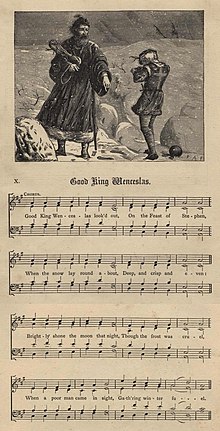
"Good King Wenceslas" (Roud number 24754) is a Christmas carol that tells a story of a tenth century Bohemian king (modern-day Czech Republic) who goes on a journey, braving harsh winter weather, to give alms to a poor peasant on the Feast of Stephen. The Feast of Stephen is December 26, the Second Day of Christmas in Western Christianity. In Eastern Christianity, it is December 27. [Need further clarification on whether it was celebrated on Dec 26 or 27 in Wencesalas's lifetime and region.] During Wenceslas's time, the Julian Calendar was in use. During the 900s, the day that they called December 26 was actually December 31 according to the Gregorian Calendar (the current calendar).[1] And the day that they called December 27 was January 1.[1]
During the journey, his page is about to give up the struggle against the cold weather, but is enabled to continue by following the king's footprints, step for step, through the deep snow. The legend is based on the life of the Saint Wenceslaus I, Duke of Bohemia (907–935), who was not a king in his lifetime but had that status conferred on him after his death.
In 1853, English hymnwriter John Mason Neale wrote the lyrics in collaboration with his music editor Thomas Helmore to fit the melody of the 13th-century spring carol "Tempus adest floridum" ("Eastertime Is Come"), which they had found in the 1582 Finnish song collection Piae Cantiones. The carol first appeared in Carols for Christmas-Tide, published by Novello & Co the same year.[2][3]
- ^ a b https://legacy-www.math.harvard.edu/computing/javascript/Calendar/index.html Harvard University Online Calendar Converter
- ^ Weller, Shane (9 June 1992). Christmas Carols: Complete Verses. Courier Corporation. p. 19. ISBN 9780486273976. Retrieved 18 November 2015.
- ^ "Good King Wenceslas". Hymnsandcarolsofchristmas.com. 30 September 2006. Retrieved 18 November 2015.
